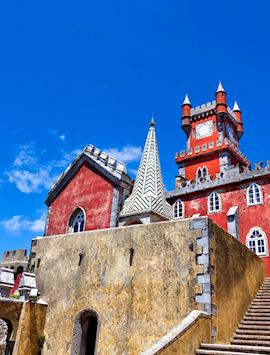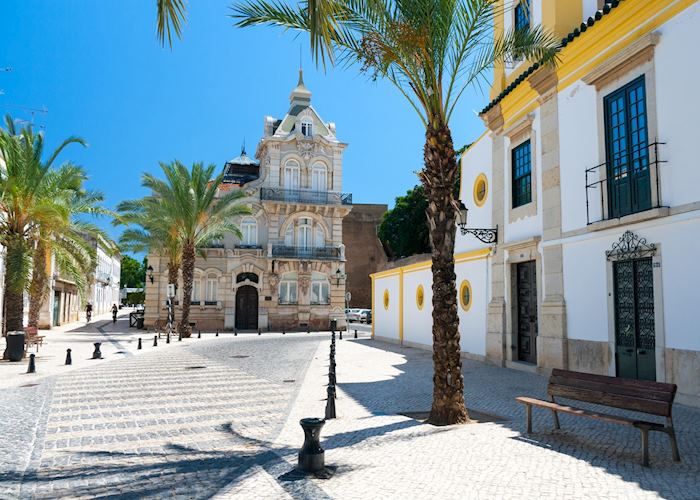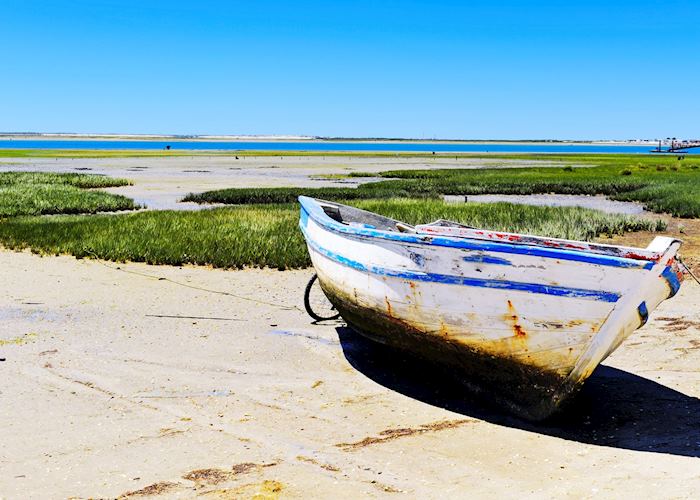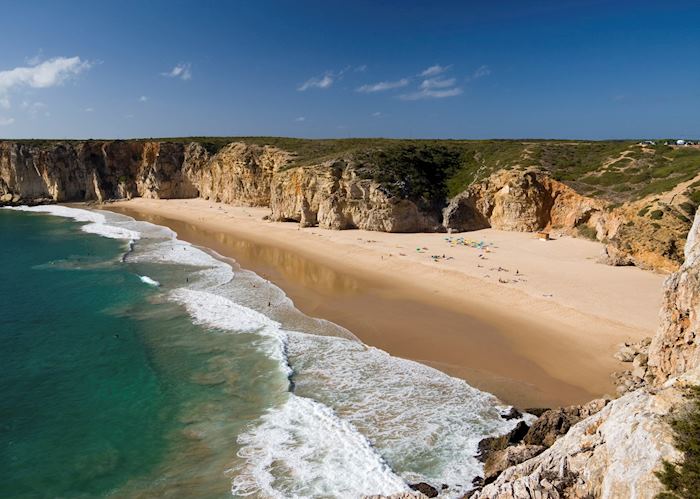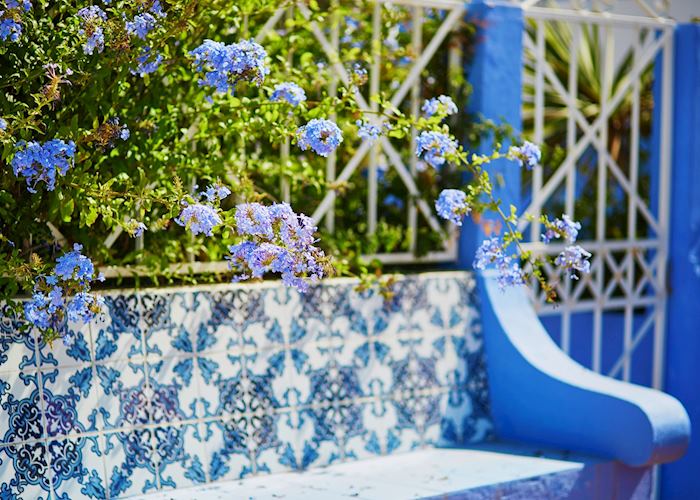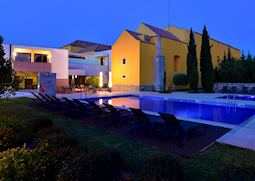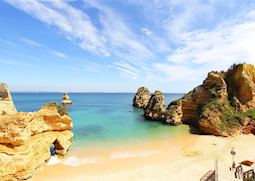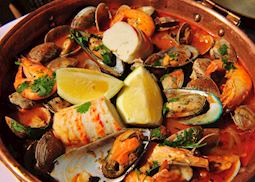Jump to:
With sunny skies, golden sands and calm, azure waters, the Algarve seems more like a stretch of the Mediterranean than the Atlantic. That has made it a popular beach retreat and it’s woefully built up in places. But, if you know where to look there are still Moorish and Roman ruins, pristine nature reserves and towns that retain plenty of historic character, as well as vast orchards of olives and cork.
Spain & Portugal specialist TaliaWhile the Algarve can be crowded, there are also some beautiful hidden pockets where you can really appreciate each beach. And, the food here is excellent — perfectly fresh seafood, grilled with just salt, pepper and olive oil.
Things to see and do in the Algarve
Faro
Sprawling and modern, Faro is the provincial capital of the Algarve, and at first glance it doesn’t seem to offer much. But city’s Cidade Velha (Old Town) merits a second look.
 Doubly devastated by British looting and the Lisbon earthquake, the area has been reconstructed repeatedly. The winding streets are paved in patterns with black and white cobblestones and the closely crowded buildings exude a Mediterranean sort of appeal, with peeling whitewash and black wrought-iron balconies.
Doubly devastated by British looting and the Lisbon earthquake, the area has been reconstructed repeatedly. The winding streets are paved in patterns with black and white cobblestones and the closely crowded buildings exude a Mediterranean sort of appeal, with peeling whitewash and black wrought-iron balconies.
There are several historic churches in the area, most notably the Capela dos Ossos, located behind the Igreja de Nossa Senhora do Carmo. The white-faced church has a Baroque façade, twin belfries and an outrageously gilded interior. Most visitors are there to see the small chapel out back, which is decorated with the skeletons of more than 1,000 monks. Blank-eye skulls stare from walls, embedded within geometric designs created from leg and arm bones.
Parque Natural da Ria Formosa
At the edge of the Old Town, the Ria Formosa is a vast system of saltwater lagoons and shallow marshes, barrier islands and creeks. An ever-changing landscape sculpted by wind and tides, it provides a vital resting point for birds migrating between Africa and Europe.
Birdwatchers can take eco-boat tours to spot the many species of the Ria Formosa, including (some rare) ducks, waders and shorebirds. It’s also the preferred nesting spot of the purple gallinule and one of the last places to find a European chameleon in the wild.
You can also see local fishermen wading through the mudflats, gathering the oysters that thrive in the silt-rich water.
Tavira
Tavira is located on the eastern edge of the Ria Formosa and the Parque Natural da Ria Formosa protects the town’s beaches, making them some of the least developed in the country. Just a short ferry ride from the main town, you’ll find Ilha de Tavira, a strip of land that boasts aquamarine waters and miles of broad golden beaches, fringed with seagrasses.
But there’s more to Tavira than just the beaches. Wandering through the warren of cobblestone streets reveals shady plazas and historic gardens. There are also many medieval and Renaissance churches, as well as an old Roman bridge. The hilltop castle was damaged in the Great Earthquake and, today, a garden grows amid the dilapidated stone walls, full of fuchsia bougainvillea and brilliant purple jacaranda trees.
Castro Marim
Even farther east, on the border with Spain, Castro Marim is far from the madding crowds. Historically, the city was important for its salt production, which supplied much of the region’s wealth. It still has two forts perched on hills that overlook the hip-roofed houses. There’s no bustle here, just tree-lined streets and small cafés where locals go about their daily business.
Castro Marim is on the edge of the Reserva Natural do Sapal de Castro Marim, a saltwater marshland known for its populations of white storks and wheeling flocks of flamingoes. The marshes were also a source of salt for ancient Romans. Workers still exploit the salt pans to produce salt by hand, using traditional methods and eschewing modern machinery for gravity-fed systems.
Lagos
West of Faro, Lagos is perhaps the most popular destination in the Algarve. As a port for Henry the Navigator’s maritime explorations, the town has hosted carousing sailors and other visitors for centuries and not much has changed over the years.
There’s a thumping nightlife, especially in the summer, and the old town boasts 16th-century walls and narrow cobblestone streets. Beaches are wide, well groomed and thronged with sunbathers and surfers. Despite this, you still glimpse the natural beauty that made this stretch of the coast so inviting. Just a short way out of the city is Ponta da Piedade (Point of Piety) with its hidden inlets and golden sandstone cliffs carved into fantastical shapes.
Sagres
Perched on a rocky promontory at the extreme southwestern point of the continent, the village of Sagres earns its nickname as ‘o fim do mundo,’ the end of the world. This is where Henry the Navigator founded his maritime school and launched Europe’s Age of Discovery, sailing off into (literally) uncharted waters.
The sense of being at land’s end is particularly strong from the high, wave-sheered cliffs of Cabo de São Vicente, a cape just outside town. With the whole of the continent behind you and all the Atlantic in front, the ocean views here are vast and wild, particularly at sunset.
Best time to visit the Algarve
Though it’s sunny and mild year-round, the Algarve can get very busy in the summer (June to August). We suggest planning your trip between March and May or in September or October.
who's been there
-
617-223-4521617-223-4772
- Make an inquiry
Suggested itineraries featuring Algarve
Our itineraries will give you suggestions for what is possible when you travel in Algarve, and they showcase routes we know work particularly well. Treat them as inspiration, because your trip will be created uniquely by one of our specialists.
Places near Algarve
- Évora & the Alentejo 108 miles away
- Lisbon 135 miles away
- Belém 136 miles away
- Estremadura 136 miles away
- Sintra 147 miles away
- Coimbra 222 miles away
- Douro Valley 288 miles away
- Porto 289 miles away
Photos of Algarve
Accommodation choices for Algarve
We've selected a range of accommodation options for when you visit Algarve. Our choices usually come recommended for their character, facilities and service or location. Our specialists always aim to suggest properties that match your preferences.
-
![Praia Verde Boutique Hotel, Castro Marim]()
Praia Verde Boutique Hotel
Algarve -
![Anantara Vilamoura, Vilamoura]()
Anantara Vilamoura
Algarve -
![Octant Vila Monte, Moncarapacho]()
Octant Vila Monte
Algarve -
![Pousada Convento de Tavira, Tavira]()
Pousada Convento de Tavira
Algarve -
![Vila Vita Parc Resort & Spa, Porches]()
Vila Vita Parc Resort & Spa
Algarve
Ideas for experiencing Algarve
Our specialists seek out authentic ways to get to know the places that could feature in your trip. These activities reflect some of the experiences they've most enjoyed while visiting Algarve, and which use the best local guides.
-
Lagos coastal walk and Sagres visit ![Seascape, Algarve]()
Lagos coastal walk and Sagres visit
Lagos coastal walk and Sagres visit
Explore Portugal’s southern coast on this full-day walking tour from Lagos. The hike takes in the city itself as well as the cliffs at the Ponta da Piedade, before heading for the remote village of Sagres overlooking the Atlantic.
View details -
Market to plate cataplana cooking class ![Cataplana, Algarve]()
Market to plate cataplana cooking class
Market to plate cataplana cooking class
Learn how to make the Algarve’s signature dish — cataplana — a combination of fresh seafood, vegetables and spices, on this half-day cooking course with a private chef. You’ll be guided around Faro’s central market and then cook the dish in a local restaurant in the city’s historic old town.
View details


